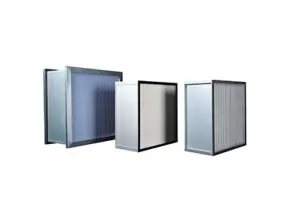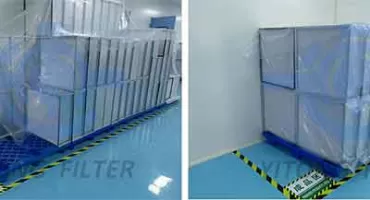 July 24, 2025
July 24, 2025
Indoor air quality is critical for maintaining a healthy, safe, and comfortable environment, especially in residential, commercial, and industrial settings. One of the most common filters used to keep indoor air clean is the G4 air filter. Known for its reliable performance and cost-effectiveness, the G4 filter is a preferred choice for HVAC systems, ventilation units, and various industrial applications.
In this blog post, we’ll explore everything you need to know about G4 air filters—what they are, how they work, their key benefits, and how to choose the right G4 filter for your needs.
A G4 air filter is a coarse filter designed to capture larger airborne particles such as dust, pollen, fibers, and debris. According to the EN779:2012 standard, G4 is classified as a coarse filter with an average particle collection efficiency of >90% for particles larger than 10 microns.
In the newer ISO 16890 standard, G4 filters generally fall into the ISO Coarse (ePM10 < 50%) category.
G4 filters are often used as pre-filters in HVAC systems to protect more expensive fine filters (like F7 or HEPA filters) from clogging.
The G4 filter uses a dense synthetic fiber media or glass fiber mat to trap airborne particles. As air passes through the filter, larger particles are caught on the surface or within the fibers, allowing cleaner air to flow downstream.
The structure of a G4 filter is typically:
Filter Media: Synthetic non-woven fiber or glass fiber.
Frame: Galvanized steel, aluminum, or cardboard.
Design: Flat panel or pleated to increase surface area and dust-holding capacity.
G4 filters are versatile and widely used across different industries and environments. Common applications include:
1. Residential HVAC Systems
Used in home air conditioners and furnaces to trap dust and pollen.
2. Commercial Buildings
Installed in office ventilation systems to improve indoor air quality.
3. Industrial Facilities
Used as pre-filters in manufacturing plants and warehouses.
4. Cleanroom Systems
Protect sensitive fine filters like HEPA or ULPA by capturing large contaminants first.
5. Public Buildings and Schools
Helps create a healthier environment by filtering common allergens.
1. Cost-Effective
G4 filters are less expensive compared to fine filters, making them a budget-friendly choice for pre-filtration.
2. Extended Life of Fine Filters
By trapping large particles, G4 filters reduce the workload of downstream filters like HEPA, extending their service life.
3. Energy Efficiency
Their low pressure drop ensures that HVAC systems don’t work too hard, leading to lower energy consumption.
4. Versatile and Easy to Install
They come in standard sizes and are easy to fit into most air handling units (AHUs).
To ensure reliable performance, G4 air filters are tested according to international standards:
EN779:2012 – Classifies G4 as a coarse filter with a minimum arrestance of ≥90% for synthetic dust.
ISO 16890 – G4 filters usually align with the ISO Coarse category.
When selecting a G4 filter, consider the following factors:
1. Filter Size – Check the dimensions of your HVAC system or filter housing.
2. Frame Material – Choose between cardboard, metal, or plastic depending on your environment.
3. Media Type – Synthetic fibers are durable and moisture-resistant.
4. Dust Holding Capacity – A higher capacity means longer service intervals.
5. Compatibility – Ensure the G4 filter fits with any downstream filters, such as HEPA or activated carbon.
Proper maintenance is key to keeping your G4 filter efficient:
Inspect Monthly: Check for visible dust buildup.
Replace Every 3–6 Months: Depending on usage and air quality.
Avoid Washing: Most G4 filters are disposable and should not be washed unless specifically designed to be washable.
G4 Filter: Designed for coarse filtration (dust, hair, pollen).
F7 Filter: A fine filter with a higher efficiency for smaller particles (PM2.5, fine dust).
Combination Use: G4 filters are often paired with F7 or HEPA filters to form a multi-stage filtration system.
A G4 air filter is a practical, cost-effective solution for improving air quality and protecting HVAC systems. Whether used in homes, offices, or industrial facilities, G4 filters effectively capture large airborne particles and extend the life of downstream filters. By choosing the right G4 filter and replacing it regularly, you can maintain clean, healthy indoor air while optimizing energy efficiency.
If you’re looking for a reliable G4 air filter supplier, consider working with a trusted manufacturer that follows international filtration standards and offers customizable solutions.
1. What does G4 mean in air filters?
G4 refers to the filtration class of the air filter, based on the EN779:2012 standard. A G4 filter is classified as a coarse filter with a minimum arrestance of 90% for particles larger than 10 microns.
2. What is the difference between a G4 and an F7 air filter?
G4 filters capture large particles like dust and hair, while F7 filters trap finer particles, such as PM2.5 and pollen. G4 filters are often used as pre-filters before F7 or HEPA filters.
3. Can I wash and reuse a G4 filter?
Most G4 filters are disposable and should be replaced when clogged. Some models are washable, but always check the manufacturer's instructions to avoid damaging the filter.
4. How often should I replace a G4 air filter?
Typically, G4 filters should be replaced every 3–6 months, depending on air quality, usage, and the specific environment where they are installed.
5. Is a G4 filter good for home HVAC systems?
Yes. G4 filters are commonly used in residential HVAC systems because they effectively remove large particles like dust, pet hair, and pollen, improving indoor air quality.
6. What are the dimensions of standard G4 air filters?
G4 filters come in standard HVAC sizes (e.g., 595×595×48 mm) but can also be customized to fit specific air handling units (AHUs) or ventilation systems.
7. Are G4 filters energy efficient?
Yes. G4 filters have a low pressure drop, which allows air to flow freely through the system, reducing energy consumption while maintaining good filtration performance.
8. Can G4 filters remove smoke or odors?
No. G4 filters are designed for coarse particles. To remove smoke, odors, or gases, you need additional filtration, such as an activated carbon filter or higher-grade fine filters.
9. Do G4 filters meet ISO 16890 standards?
Under the newer ISO 16890 standard, G4 filters are categorized as ISO Coarse filters with an ePM10 rating of less than 50%.
10. Where can I buy high-quality G4 air filters?
You can purchase G4 filters from HVAC suppliers, online marketplaces, or directly from manufacturers that offer custom sizing and bulk ordering for industrial applications.
 Oct. 15, 2024
Industry Applications of H13 True HEPA Filters: Clean Air for Critical Environments
Oct. 15, 2024
Industry Applications of H13 True HEPA Filters: Clean Air for Critical Environments
 Sep. 01, 2023
H14 Separator HEPA Air Filters Ordered by Canadian Customer
Sep. 01, 2023
H14 Separator HEPA Air Filters Ordered by Canadian Customer
The H14 separator HEPA air filters ordered by the Canadian customer have been shipped.
 Jun. 02, 2023
High Flow Filter Cartridge: Enhancing Filtration Efficiency and Performance
Jun. 02, 2023
High Flow Filter Cartridge: Enhancing Filtration Efficiency and Performance

